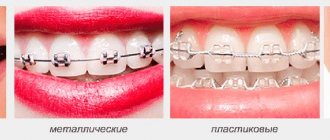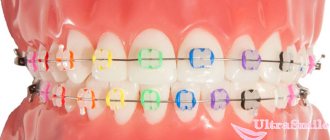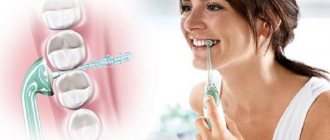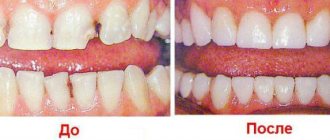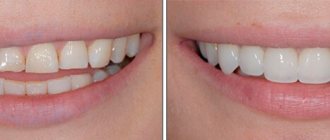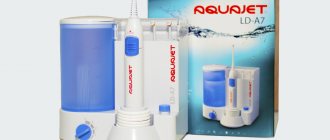It's never too late to make your smile beautiful and attractive. For this purpose, modern dentistry uses various orthodontic structures that can correct malocclusion and straighten teeth. Most people associate straight teeth with a beautiful smile, but it is worth remembering that uneven teeth are more difficult to care for, which may require many more visits to the dentist: for the treatment of caries, and maybe for removal, and then for prosthetics.
The most common designs for correcting malocclusion are braces. The most popular recently are the so-called sapphire braces. Their popularity is due to their aesthetic appearance and efficiency. This non-removable device has a streamlined shape without sharp corners, so the process of getting used to them, in comparison with traditional ones, is minimized. However, it is worth keeping in mind that such braces are only suitable for snow-white teeth. If the enamel has a yellowish tint, sapphire braces will be very noticeable.
What is this system?
This name is given to bracket systems, the base of which is made of artificially grown sapphire crystals. At its core, the material is monocrystalline aluminum oxide.
Despite the “artificial” nature, this material does not cause allergies and is completely safe for the human body . It can be classified as ceramics. The difference between sapphire and ceramic braces is that polycrystalline aluminum oxide is used to produce the latter.
For crystallization (“crystal growing”), the starting material is exposed to very high temperatures – 2050°C. After special cutting and polishing, braces have the ability to transmit light . This is what makes them transparent and invisible after installation.
During the cutting process, each element is given a rounded shape, which allows the patient to practically not feel the foreign structure in the mouth, since it does not damage the mucous membrane .
Features of caring for sapphire braces
Adult patients prefer polymer materials to metal that is too visible. Sapphire braces are transparent, lightweight and ultra-thin, which allows you to avoid drawing unnecessary attention to your smile. In general, caring for sapphire braces is practically no different from the above rules. However, orthodontists recommend remembering several important nuances. Firstly, it is forbidden to smoke, drink tea and coffee in large quantities. Violating this rule will result in expensive transparent braces acquiring a yellowish tint. You will also have to rinse your mouth not twice a day, but after each meal. After all, any dirt stuck behind the ligatures will be visible to others.
We must not forget that the polymer material is quite fragile. Orthodontists recommend purchasing a special protective mouthguard, which must be worn whenever active sports are planned.
If you adhere to all the above rules, then you don’t have to worry about the condition of your teeth after removing braces.
Device and principle of operation
Not only the device, but also the principle of operation of such systems are identical to classic braces made from other materials.
The system consists of three main elements:
- The first is the braces themselves. They are miniature locks that have wings and a groove for the arc.
- The arc is the main active component. After its installation (passed into the groove of each lock), the braces are connected into a single system.
- Ligatures are small fasteners that help hold the archwire in the groove.
The principle of operation is based on the fact that the teeth in the jaw are fixed in such a way that they can slightly change their position. Moreover, the change is possible in any direction - towards neighboring teeth or around the central axis - if constant and prolonged slight pressure is applied to the tooth.
The arc is made of a material that has so-called shape memory - it tends to take its original position . It is she who produces this pressure, gradually changing the position of each desired tooth.
How to fix uneven teeth for an adult
Nowadays, the orthodontic capabilities of dentistry have advanced greatly, and now it is possible to correct the bite not only of a child, but also of an adult. For this purpose, the technique of correction braces is used - special devices consisting of a metal arch on which plates are fixed, made either of metal or of other materials. The bite is corrected by pressing these plates on the teeth, which is adjusted by the dentist.
He has to wear these corrective devices on his teeth for quite a long time - at least for six months. Naturally, this cannot but cause a person certain inconveniences, especially noticeable at first, but beauty, as they say, requires sacrifice.
In addition to purely physiological discomfort caused by the constant presence of a “foreign body” in the mouth, there is also discomfort of a psychological nature. After all, braces are a fairly noticeable detail, and they involuntarily catch the eye of others as soon as a person opens his mouth.
Trying to correct this situation, manufacturers offer teenagers braces in the form of stars, fish, etc., but this is not very consoling for the latter. And it is not very convenient for an adult, especially if he holds a responsible official position, to “show off” braces at an important meeting or during business negotiations.
What should you do - stay with uneven teeth, or put up with a temporary metallic shine in your mouth in the name of a beautiful smile in the near future?
Main disadvantages
These orthodontic devices have very few disadvantages compared to other types of braces.
Minuses:
- The first and most significant of them is high cost. To a greater extent, the complexity of production and processing of each bracket and the need to use expensive equipment play a role here.
- A fairly long period of bite correction with the help of these systems.
- Despite the high strength of the base material, it is very fragile, forcing patients to treat the installed device very carefully.
- They are practically not used to correct serious malocclusions.
Methods for fixing braces
A direct and indirect method for fixing ligature and non-ligature models in the oral cavity has been developed. The direct method involves installing and positioning each element manually.
The indirect method requires less time during the appointment. The main work is carried out on plaster models of jaws (casts). Stages of the indirect fixation method:
- The orthodontist takes an impression of the jaw;
- makes a plaster model of the jaw;
- positions the braces manually on the model and transfers them to the mouth guard;
- when the patient comes for an appointment, the doctor applies adhesive to the braces in the tray;
- The orthodontist puts on a mouthguard, all elements are fixed on the teeth at once;
- The mouthguard is removed, excess adhesive is removed, and if necessary, the position of the braces is additionally adjusted in a targeted manner.
indirect fixation of self-ligating Damon Q braces
The indirect method is more comfortable for the patient and the doctor. The approach is especially relevant for people who cannot or do not want to spend a lot of time in the dental chair.
Working with ligature structures takes more time. In addition to positioning and installing the system elements, it is necessary to fix the arch with ligatures. This means that the doctor must manually install a ligature on each of the 20 braces.
Reviews from orthodontists about the Damon self-ligating bracket system
Practicing orthodontist and experienced teacher Tikhonov A.V. in the book “Control of tooth inclination when using the Damon passive self-ligating system” indicates that torque losses during treatment with self-ligating braces are reduced due to the conscious choice of torque for each specific tooth. A large selection of torque options for Dimon braces, combined with the highly qualified orthodontist, provides reliable control over bite correction.
treatment on Damon
According to Dr. Tagawa D., Damon bite correction reduces the number of doctor visits by almost 50% compared to the number of visits for patients with ligature structures. The treatment period is reduced by an average of 7.2 months. The use of ligature-free models increases the profitability of the clinic due to fewer visits and shorter treatment times.
Orthodontist Jeffrey Jr.
Eberting from Temple University, USA, conducted a comparative study of the timing, results and patient satisfaction of using the Damon self-ligating system and conventional braces. The results of the analysis of jaw models after completion of treatment were better in individuals of both sexes who received Dimon. Most patients rated the duration of treatment as shorter than expected. The material is for informational purposes only and is presented for informational purposes. It does not replace consultation with an orthodontist and is not a guide to correcting dental anomalies.
Manufacturers
These orthodontic appliances are made by different manufacturers.
Inspire ICE from Ormco
They take into account all the shortcomings of previous generations, so Inspire ICE are deservedly popular.
photo: before and after treatment
The special platform of each bracket has a special coating of microscopic zirconium balls , which, when applied with an adhesive, create maximum adhesion force to the tooth. At the same time, the properties of the coating make it easy to remove braces after treatment.
Damon Clear
This is a self-ligating passive system that has several advantages. In particular, this concerns the design. First of all, we should note the diamond shape and rounded edges, which increase wearing comfort. Using this system, there is no need for frequent visits to the dentist to activate the archwire.
photo: before and after
The groove is closed using a special patented Spin Tek mechanism, which allows the necessary manipulations (replacement of the arc) to be carried out quickly and without causing discomfort to the patient.
When opening the lock there is no pressure on the tooth. The attachment to the enamel surface is very strong and reliable , thanks to laser etching of the bracket base.
Miso
Also a non-ligature system, the difference of which is the free fixation of the arch without blocking it. This is achieved thanks to the presence of special sliding clamps in the design, which are similar in appearance to a valve.
This type of fixation simplifies the correction and allows you not to visit the orthodontist too often, and also facilitates care.
Radiance from American Orthodontics
The main advantage of this classic ligature system is the special base of each bracket, which has a patented name “Quad-Matte”.
Its peculiarity is that along the perimeter the attachment to the enamel is much weaker than in the central part. This ensures the safety of the enamel and ease of removal without damaging the teeth or using special tools.
Pure by OrthoTechnology
They are distinguished by their neat shape, miniature size and fastening strength , which is ensured by applying powdered zirconium dioxide to the base of each element.
photo: treatment result
The installed system looks like a decoration, as it transmits not only natural daylight, but also neon. Because of this feature, it is suitable for active young people.
Alternative to self-ligating design
An alternative to a self-ligating design is ligature braces. The word “ligature” comes from the Latin word “ligature” - a ligament. The arch is tightly fixed to each bracket using ligatures and, due to “shape memory,” pulls the teeth in the desired direction. “Classic” models correct various malocclusion pathologies: from anomalies in the position of individual teeth to complex complex cases.
metal ligature braces Mini Diamond
There are wire and elastic ligatures. Wire structures fix the arc as tightly as possible. They are more reliable, but provide worse sliding. Elastics are made from rubber and caoutchouc in various colors. Elastic materials tend to stretch, can sometimes tear and require regular replacement.
Comparison of self-ligating and ligature braces
Depending on the method of fixing the arch sliding in the grooves of the braces, ligature and non-ligature (self-ligating) systems are distinguished.
self-ligating Damon Q2 and Orthos ligature braces
Let's compare self-ligating and ligature models.
1. Method of fixing the arc. In “classical” systems, the arch is held in place by ligatures, and in non-ligature systems, by a lid or clip.
arc in groove Damon Clear
2. Material of manufacture. Ligature and non-ligature devices are made from various materials. Here are some examples:
- Damon Clear2 self-ligating ceramic braces;
- metal Damon Q, 3MX;
- ligature Inspire Ice made from artificially grown sapphire;
- in the manufacture of Orthos and Mini Diamond, the material used is stainless steel;
- Titanium Orthos are made of titanium.
sapphire ligatures Inspire ICE
The choice depends on the clinical case, preferences and financial capabilities of the patient.
3. Price. The cost depends on a number of factors.
- The presence of a mechanism for closing/opening the lid or clip. Due to the complexity of manufacturing, the price of non-ligature self-ligating braces is higher than that of devices with ligatures.
- Materials of manufacture: for example, ceramic ones are more expensive than steel ones.
- Areas of fixation: vestibular, on the outer surface, or lingually, on the inner surface of the dentition. The cost of lingual ones is higher.
4. Duration of treatment. “Classic” devices are worn on average from 2 to 3.5 years. Without ligature – 20–30% less. Bite correction with Dimon can reduce the number of visits and the overall duration of treatment by several months. The period is different for each person. The doctor indicates the approximate period of time after calculating the diagnostic models and the patient’s TRG.
5. Discomfort during treatment . The Damon self-ligating brace system brings less discomfort to the patient due to the work of low forces and reduced friction. In addition, pain sensations depend on individual characteristics: pain threshold and jaw anomalies to be corrected.
6. Treatment effectiveness. Non-ligature structures are capable of correcting clinical cases of varying levels of complexity, gently and carefully building the correct bite. Appliances with ligatures also correct complex jaw anomalies. However, self-ligating braces reduce the time required for bite correction and provide a long retention period.
7. Care. Oral hygiene with ligature devices is more difficult. Food gets stuck between the bracket, archwire, and elastics, and cleaning the system takes longer. If the patient neglects careful hygiene, multiple caries lesions and periodontal diseases are possible. Because of this, additional therapeutic treatment may be required after the structure is removed.
8. Adaptation. Getting used to any type of device is not easy in some cases. A foreign object appears in the oral cavity, which, of course, interferes. Adaptation to the non-ligation system is easier due to the small size and atraumatic shape of the elements. The absence of additional elements in the form of ligatures also makes it easier to get used to.
Ligature and non-ligature
Sapphire braces can be made in two types.
The classic case is when the system is equipped with ligatures to hold the arc - fastenings that are small elastic bands or thin wire rings. Rubber ligatures wear out quite quickly , so they have to be changed by your doctor.
Non-ligating braces are also called self-ligating braces. They are radically different from ligature ones in their structure. Each bracket is equipped with a lock that snaps into place and firmly secures the archwire , allowing it to slide. In this case, no additional fastenings are required, and the friction force will be much less.
Self-ligating systems are more expensive and in many cases more effective, as well as easier to use - there is no need to change the ligatures if they change color, become deformed or break.
However, they are not always better. The fact is that during the treatment process it may be necessary not only to replace the arc , but also the density of its fastening. When the contact with the walls of the groove is loose, this is a passive type of fastening, and if the arc is fastened very tightly, this is an active type.
Sometimes you need to change the force on your teeth. In the case of a classic ligature system, this is quite simple - the doctor can slightly loosen the fastenings , allowing the arc to slide freely or vice versa.
But self-ligating systems can be equipped with only one (passive or active) type of fixation. This may affect the duration of treatment, prolonging it.
Price
The price of sapphire braces in Moscow depends on various factors. On average, their cost varies from 25,000 rubles and above. If all braces are made of sapphire, then their cost increases significantly. If sapphires are installed only in visible areas, and ceramics or metal are used on distant teeth, this significantly reduces the cost of the structure. Before choosing sapphire braces, study information about them on the Internet, read people's reviews and compare the cost of products in Moscow.
What arcs are used?
Unfortunately, there are no transparent arches that have the qualities necessary for braces. a classic metal arc is inserted into sapphire systems . It is a little noticeable during a conversation, but does not create the effect of “metal staples”.
In such systems, to maximize their aesthetics, you can use metal arches that have a white coating of a material similar to Teflon.
In this case, the braces become completely invisible. The only drawback of such arches is that the aesthetic coating can gradually wear off due to strong friction.
Orthodontic wax and irrigator: additional elements of the standard set
The use of orthodontic wax can significantly reduce the discomfort caused by metal braces.
Very often, protruding elements of the braces system scratch the delicate tissues of the oral cavity. Wax protects gums, inner lips and cheeks from sores and scratches. The wax is sold in small plastic boxes and has a structure similar to soft chewing gum. Using the product is quite simple: you need to tear off a little wax from the container, warm it in your palms, and then apply directly to the lock or bracket that is causing irritation. Don't worry that some of the wax will be accidentally swallowed, because dental products are non-toxic. Another optional, but very useful device designed to make caring for braces easier is an irrigator. This dental device is used to clean the spaces between braces and teeth. The irrigator acts as a small pump that directs a stream of water to the desired location.
Which systems are better and how do they differ?
At the moment, most orthodontists agree that to correct significant malocclusions, the ideal option is to install a metal brace system.
This is due to its reliability, maximum strength and the ability to use large forces to move teeth. However, it has one significant drawback - the metal on the outer surface of the teeth stands out and spoils the impression of a smile.
As opposed to metal, special ceramics and artificially grown sapphire crystals began to be used in orthodontics. Both of these materials are less durable than metal, but are strong enough to perform their functions .
The option of sapphire artificial crystals is most preferable for those for whom the aesthetic side of the issue is very important, since transparency and high light transmittance make them invisible.
Ceramic braces have properties similar to sapphire ones, but have a matte tint , which will be noticeable on white enamel. The strength of ceramics is almost the same as that of a transparent crystal. In addition, both materials do not stain during wear and retain their ideal appearance throughout the entire treatment period.
Differences between sapphire, ceramic and metal braces
Bracket systems are made from different materials, and therefore each option has its own differences, pros and cons:
- Classic metal braces. They cope well with various malocclusion pathologies and remain the most affordable. They are inferior to sapphire and ceramic products due to their not entirely aesthetic appearance.
- Ceramic braces are made from high-quality and hypoallergenic ceramics. They are almost invisible on the teeth, since the color of the ceramic is similar to the color of the teeth. They are suitable for correcting various malocclusion pathologies and are strong, durable and resistant to staining. However, if you regularly consume coloring foods and drinks, they may darken. Unlike metal products, they have a more aesthetic appearance. When comparing them with sapphire braces, cost plays a significant role. Ceramic braces are more affordable;
- Sapphire braces are a type of ceramic braces, but they are more transparent. Sapphire products are not painted. They are distinguished by their aesthetics, efficiency, and hypoallergenicity. However, at the same time, for most people such products in Moscow are too expensive.
Installation
Installation always takes place in several stages.
- Diagnostics. At the very beginning, the doctor conducts a complete diagnosis not only of the type of anomaly, but also of the entire oral cavity. Possible treatment options (for example, installation of a ligature or self-ligating system) are discussed with the patient. A visual examination is carried out, as well as detailed studies - orthopantomogram, photographs, etc.
- Preparation. Since the installation of sapphire braces can only be carried out on healthy teeth, the oral cavity is sanitized - all problems are eliminated (treatment of caries, other diseases) and professional hygiene is carried out.
- Taking impressions. Before making it, the doctor must take an impression of both jaws of the patient. This is necessary for making a working model and precise fitting of braces.
- Ordering braces and waiting for them to be made. The wait is inevitable, since in each case the installation is carried out purely individually - the location and shape of the bracket is determined for each tooth.
- Installation. In order to install braces, one visit is enough, but it requires from 1.5 to 3 hours of time spent in the dentist’s chair. The doctor secures each brace separately and only after that installs the arch
In what cases are braces placed?
The very essence of such treatment is the forced alignment of the dentition - this is the first thing that those who doubt the need to install them need to know about braces. Only these systems guarantee a visual effect within 10–12 months and can work even in complex cases of twisted or crooked teeth in adults.
In what cases are braces placed? Common indications for installation are:
- broken bite;
- facial asymmetry;
- presence of tooth gaps;
- crooked or twisted teeth;
- previous jaw injuries or other pathologies that provoked temporomandibular anomalies (crunching and characteristic discomfort may be present when chewing);
- unevenness of the dentition - protruding or recessed individual teeth.
There are different types of braces for children and adults. Their choice is always a joint work of the treating orthodontist and the patient.
Whichever option you choose, our specialists will conduct a detailed consultation taking into account the goals and individual priorities of each patient. Depending on which teeth the braces are placed on (type of malocclusion), we will help you choose the best option, prepare you for the procedures, and carry out all installation work without discomfort, pain, or fear.
Who is it prescribed to?
Such orthodontic appliances are prescribed to patients who have relatively simple problems with the position of their teeth:
- malocclusion;
- spaces between teeth;
- torsion.
It is also important that people who may have allergic reactions to other materials can undergo treatment using such systems.
In this case, the age and gender of the patient (from 14 years old) do not matter. However, you should note that sapphire models are more suitable for patients with white tooth enamel . In the case of a natural yellowish color, aesthetics decreases, since the appliance becomes more noticeable on yellow teeth.
Causes and consequences of incorrect bite changes
In this case, doctors advise removing them, even if they are not affected by caries. But parents do not want to once again traumatize the child’s psyche by visiting the dental office. They hope that sooner or later the baby tooth will fall out on its own, without the help of a doctor. And when this happens too late, the permanent tooth, crawling out of the jaw, is forced to forcefully “push” the lingering “usurper” from its rightful place.
It is not difficult to correct uneven teeth in children, since in childhood the entire jaw apparatus is in the stage of formation, which allows it to be very plastic. To do this, you just need to wear a special plastic plate in your mouth for some time (no more than a few months). But, since this causes a certain inconvenience to the child, he, sometimes accidentally, and sometimes deliberately, “forgets” to put it on.
The appearance of a malocclusion is also possible in an absolutely adult person who previously had straight teeth at a mature age, and it is caused by untimely prosthetics when teeth are removed or injured. When this kind of “gap” forms in the mouth, it must be eliminated as soon as possible, without allowing too much time between the loss of your own tooth and the installation of an artificial one.
Otherwise, the teeth located next to the void begin to gradually move from their place: not finding the necessary support, they move to the side, up or down. In this case, a displacement of the entire dentition inevitably occurs, causing a change in the anatomically correct bite.
Because of this, the process of biting and chewing food becomes difficult, leading to indigestion, which can result in an imbalance in the normal functioning of the gastrointestinal tract, leading to chronic pathologies in this area.
Rules of care
Despite the fact that sapphire braces do not change color while worn and are quite durable, there are still certain care rules that experts advise to adhere to.
- Be sure to brush your teeth every morning and evening.
- Use an additional toothbrush – a mono-beam one.
- Use dental brushes and, if possible, an irrigator.
- Avoid eating hard and very hard foods – nuts and other things.
- Be sure to visit a doctor according to the schedule for preventive examinations and replacement of arches.
Basic rules for caring for teeth with braces
As mentioned above, proper care of the braces system begins with brushing your teeth. Using circular movements, it is necessary to clean each tooth from the outside and back. When using an electric toothbrush, it is strictly forbidden to press the head too hard against metal elements. This risks causing the bristles to break out and get stuck in the ligatures.
Next, you need to use a floss toothpick or a special brush to remove plaque from the interdental spaces. But to remove food debris directly from under the braces, waxed dental floss is suitable. To clean, you need to tear off about 30 centimeters of thread and carefully insert it under the staple. Then pull the thread under the rings and holes in the locks and make several cleaning movements. Repeat the procedure with each tooth. Next, you can begin to carry out the above-described care program directly for braces, after rinsing your mouth with salt water or a special solution.



